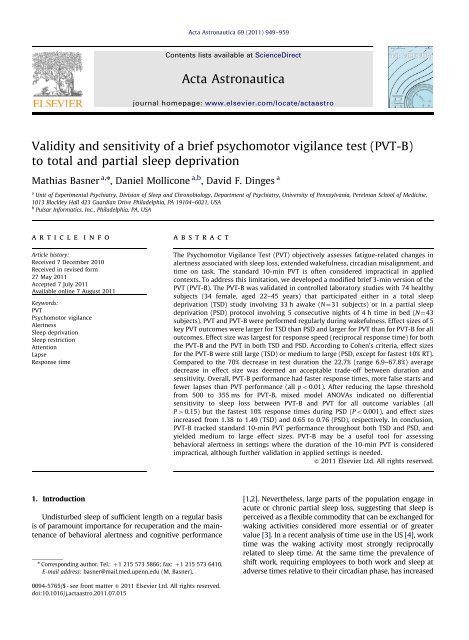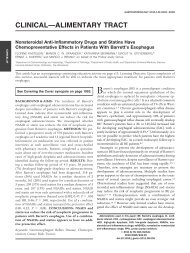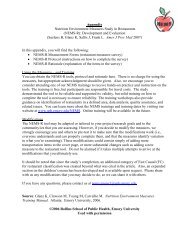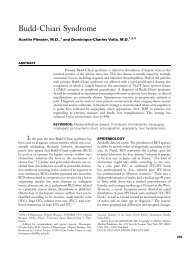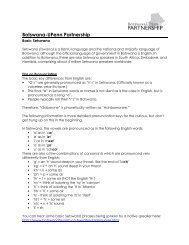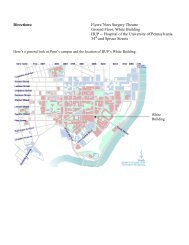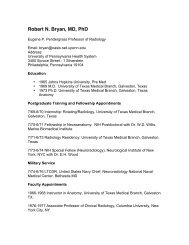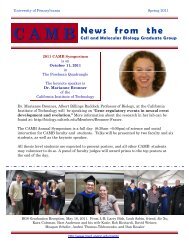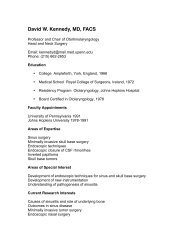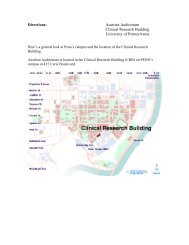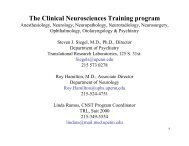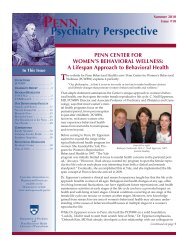Validity and sensitivity of a brief psychomotor vigilance test (PVT-B ...
Validity and sensitivity of a brief psychomotor vigilance test (PVT-B ...
Validity and sensitivity of a brief psychomotor vigilance test (PVT-B ...
Create successful ePaper yourself
Turn your PDF publications into a flip-book with our unique Google optimized e-Paper software.
<strong>Validity</strong> <strong>and</strong> <strong>sensitivity</strong> <strong>of</strong> a <strong>brief</strong> <strong>psychomotor</strong> <strong>vigilance</strong> <strong>test</strong> (<strong>PVT</strong>-B)<br />
to total <strong>and</strong> partial sleep deprivation<br />
Mathias Basner a,n , Daniel Mollicone a,b , David F. Dinges a<br />
a<br />
Unit <strong>of</strong> Experimental Psychiatry, Division <strong>of</strong> Sleep <strong>and</strong> Chronobiology, Department <strong>of</strong> Psychiatry, University <strong>of</strong> Pennsylvania, Perelman School <strong>of</strong> Medicine,<br />
1013 Blockley Hall 423 Guardian Drive Philadelphia, PA 19104–6021, USA<br />
b<br />
Pulsar Informatics, Inc., Philadelphia, PA, USA<br />
article info<br />
Article history:<br />
Received 7 December 2010<br />
Received in revised form<br />
27 May 2011<br />
Accepted 7 July 2011<br />
Available online 7 August 2011<br />
Keywords:<br />
<strong>PVT</strong><br />
Psychomotor <strong>vigilance</strong><br />
Alertness<br />
Sleep deprivation<br />
Sleep restriction<br />
Attention<br />
Lapse<br />
Response time<br />
1. Introduction<br />
abstract<br />
Undisturbed sleep <strong>of</strong> sufficient length on a regular basis<br />
is <strong>of</strong> paramount importance for recuperation <strong>and</strong> the maintenance<br />
<strong>of</strong> behavioral alertness <strong>and</strong> cognitive performance<br />
n Corresponding author. Tel.: þ1 215 573 5866; fax: þ1 215 573 6410.<br />
E-mail address: basner@mail.med.upenn.edu (M. Basner).<br />
0094-5765/$ - see front matter & 2011 Elsevier Ltd. All rights reserved.<br />
doi:10.1016/j.actaastro.2011.07.015<br />
Acta Astronautica 69 (2011) 949–959<br />
Contents lists available at ScienceDirect<br />
Acta Astronautica<br />
journal homepage: www.elsevier.com/locate/actaastro<br />
The Psychomotor Vigilance Test (<strong>PVT</strong>) objectively assesses fatigue-related changes in<br />
alertness associated with sleep loss, extended wakefulness, circadian misalignment, <strong>and</strong><br />
time on task. The st<strong>and</strong>ard 10-min <strong>PVT</strong> is <strong>of</strong>ten considered impractical in applied<br />
contexts. To address this limitation, we developed a modified <strong>brief</strong> 3-min version <strong>of</strong> the<br />
<strong>PVT</strong> (<strong>PVT</strong>-B). The <strong>PVT</strong>-B was validated in controlled laboratory studies with 74 healthy<br />
subjects (34 female, aged 22–45 years) that participated either in a total sleep<br />
deprivation (TSD) study involving 33 h awake (N¼31 subjects) or in a partial sleep<br />
deprivation (PSD) protocol involving 5 consecutive nights <strong>of</strong> 4 h time in bed (N¼43<br />
subjects). <strong>PVT</strong> <strong>and</strong> <strong>PVT</strong>-B were performed regularly during wakefulness. Effect sizes <strong>of</strong> 5<br />
key <strong>PVT</strong> outcomes were larger for TSD than PSD <strong>and</strong> larger for <strong>PVT</strong> than for <strong>PVT</strong>-B for all<br />
outcomes. Effect size was largest for response speed (reciprocal response time) for both<br />
the <strong>PVT</strong>-B <strong>and</strong> the <strong>PVT</strong> in both TSD <strong>and</strong> PSD. According to Cohen’s criteria, effect sizes<br />
for the <strong>PVT</strong>-B were still large (TSD) or medium to large (PSD, except for fas<strong>test</strong> 10% RT).<br />
Compared to the 70% decrease in <strong>test</strong> duration the 22.7% (range 6.9–67.8%) average<br />
decrease in effect size was deemed an acceptable trade-<strong>of</strong>f between duration <strong>and</strong><br />
<strong>sensitivity</strong>. Overall, <strong>PVT</strong>-B performance had faster response times, more false starts <strong>and</strong><br />
fewer lapses than <strong>PVT</strong> performance (all po0.01). After reducing the lapse threshold<br />
from 500 to 355 ms for <strong>PVT</strong>-B, mixed model ANOVAs indicated no differential<br />
<strong>sensitivity</strong> to sleep loss between <strong>PVT</strong>-B <strong>and</strong> <strong>PVT</strong> for all outcome variables (all<br />
P40.15) but the fas<strong>test</strong> 10% response times during PSD (Po0.001), <strong>and</strong> effect sizes<br />
increased from 1.38 to 1.49 (TSD) <strong>and</strong> 0.65 to 0.76 (PSD), respectively. In conclusion,<br />
<strong>PVT</strong>-B tracked st<strong>and</strong>ard 10-min <strong>PVT</strong> performance throughout both TSD <strong>and</strong> PSD, <strong>and</strong><br />
yielded medium to large effect sizes. <strong>PVT</strong>-B may be a useful tool for assessing<br />
behavioral alertness in settings where the duration <strong>of</strong> the 10-min <strong>PVT</strong> is considered<br />
impractical, although further validation in applied settings is needed.<br />
& 2011 Elsevier Ltd. All rights reserved.<br />
[1,2]. Nevertheless, large parts <strong>of</strong> the population engage in<br />
acute or chronic partial sleep loss, suggesting that sleep is<br />
perceived as a flexible commodity that can be exchanged for<br />
waking activities considered more essential or <strong>of</strong> greater<br />
value [3]. In a recent analysis <strong>of</strong> time use in the US [4],work<br />
time was the waking activity most strongly reciprocally<br />
related to sleep time. At the same time the prevalence <strong>of</strong><br />
shift work, requiring employees to both work <strong>and</strong> sleep at<br />
adverse times relative to their circadian phase, has increased
950<br />
over the past years [5]. Therefore, sleep disorders, lifestyle<br />
<strong>and</strong> work related curtailments <strong>of</strong> sleep, <strong>and</strong> working during<br />
unfavorable circadian times all may reduce neurobehavioral<br />
alertness to levels that increase the risk <strong>of</strong> errors <strong>and</strong><br />
accidents [6,7]. Prevention <strong>of</strong> these outcomes through<br />
detection <strong>of</strong> fatigue (i.e., loss <strong>of</strong> alertness, sleepiness)<br />
remains a high priority in many safety-sensitive areas <strong>of</strong><br />
human activity, <strong>and</strong> is also crucial for mission success in<br />
space flight.<br />
Objective <strong>and</strong> quantitative assessments are necessary<br />
to evaluate the presence <strong>of</strong> fatigue-related deficits <strong>and</strong> to<br />
develop strategies for fatigue mitigation, especially as<br />
self-reports <strong>of</strong> sleepiness <strong>and</strong> self-assessments <strong>of</strong> performance<br />
capability have been shown to be unreliable [8,9].<br />
In this context, neurobehavioral <strong>test</strong>s for fatigue assessment<br />
not only need to be operationally <strong>and</strong> conceptually<br />
valid, reliable, sensitive, specific, generalizable, <strong>and</strong> easy<br />
to use [10,11], but also <strong>brief</strong> enough to be acceptable for<br />
the target population <strong>and</strong> to allow for repeated administration<br />
in operational environments.<br />
Many performance <strong>test</strong>s have been developed to<br />
objectively assess the degree <strong>of</strong> cognitive performance<br />
deterioration related to sleep loss. Among these, the<br />
Psychomotor Vigilance Test (<strong>PVT</strong>) is widely used [12,13].<br />
It is based on simple reaction time (RT) to stimuli that<br />
occur at r<strong>and</strong>om intervals <strong>and</strong> therefore measures vigilant<br />
attention [14]. Auditory <strong>and</strong> visual reaction time <strong>test</strong>s<br />
have been used since the late 19th century in sleep<br />
research [15], but the <strong>PVT</strong> in its current version (i.e.,<br />
10-min duration with r<strong>and</strong>om inter-stimulus intervals<br />
(ISI) between 2 <strong>and</strong> 10 s) was proposed by Dinges <strong>and</strong><br />
Powell in 1985 [16]. When appropriate <strong>PVT</strong> outcomes are<br />
used with precision timing <strong>of</strong> RT, the st<strong>and</strong>ard 10-min<br />
<strong>PVT</strong> has proven to be very sensitive to the dynamics <strong>of</strong><br />
acute total sleep deprivation (TSD) <strong>and</strong> chronic partial<br />
sleep deprivation (PSD) [12].<br />
Sleep deprivation causes both an overall slowing <strong>of</strong><br />
<strong>PVT</strong> response times <strong>and</strong> an increase in the number <strong>of</strong><br />
<strong>PVT</strong> errors <strong>of</strong> omission (i.e. lapses, usually defined as<br />
RTsZ500 ms), as well as a smaller increase in errors <strong>of</strong><br />
commission (responses without a stimulus) [14,17]. These<br />
effects increase with time on task [18]. An advantage the<br />
<strong>PVT</strong> has over nearly all other cognitive <strong>test</strong>s is that it is<br />
virtually unaffected by either aptitude (inter-individual<br />
variability) or learning (intra-subject variability)—that is,<br />
<strong>PVT</strong> performance does not improve as a function <strong>of</strong><br />
repeated administration [19]. The <strong>test</strong> has high reliability,<br />
with intra-class correlations measuring <strong>test</strong>-re<strong>test</strong> reliability<br />
above 0.8 [13].<br />
The 10-min <strong>PVT</strong> has been shown to be a valid tool for<br />
assessing behavioral alertness <strong>and</strong> vigilant attention performance<br />
in a large number <strong>of</strong> experimental, clinical, <strong>and</strong><br />
operational paradigms. In addition to being sensitive to both<br />
TSD [17,20] <strong>and</strong> PSD [21,22], the <strong>PVT</strong> has demonstrated<br />
<strong>sensitivity</strong> to other perturbations <strong>of</strong> sleep homeostatic <strong>and</strong><br />
circadian drives; [23,24] to inter- <strong>and</strong> intra-subject variability<br />
in the response to sleep loss; [9] to the effects <strong>of</strong> jet lag<br />
<strong>and</strong> shift work; [25] <strong>and</strong> to improvements in alertness<br />
following initiation <strong>of</strong> CPAP treatment in obstructive sleep<br />
apnea (OSA) patients; [26] administration <strong>of</strong> wake-promoting<br />
drugs; [27,28] <strong>and</strong> following naps. [29] Balkin et al. [30]<br />
M. Basner et al. / Acta Astronautica 69 (2011) 949–959<br />
assessed the utility <strong>of</strong> a variety <strong>of</strong> instruments for monitoring<br />
sleepiness-related performance decrements <strong>and</strong> concluded<br />
that the <strong>PVT</strong> ‘‘was among the most sensitive to sleep<br />
restriction, was among the most reliable with no evidence<br />
<strong>of</strong> learning over repeated administrations, <strong>and</strong> possesses<br />
characteristics that make it among the most practical for<br />
use in the operational environment.’’<br />
The st<strong>and</strong>ard 10-min <strong>PVT</strong> with 2–10 s ISI is most<br />
commonly used, although both longer [18,31] <strong>and</strong> shorter<br />
[32] duration versions have been evaluated. Test duration<br />
is an important aspect <strong>of</strong> the <strong>PVT</strong> because even severely<br />
sleep deprived subjects may be able to perform normally<br />
for a short time by increasing compensatory effort. However,<br />
in a systematic analysis <strong>of</strong> <strong>PVT</strong> duration, we showed<br />
that the ability <strong>of</strong> the <strong>PVT</strong> to differentiate alert <strong>and</strong> sleepy<br />
subjects was, depending on the outcome variable, only<br />
marginally lower (<strong>and</strong> at times higher) for shorter than 10min<br />
<strong>test</strong> durations [12]. Therefore, optimal <strong>PVT</strong> duration<br />
may be shorter than 10-min for some outcome variables,<br />
demonstrating feasibility <strong>of</strong> shorter versions <strong>of</strong> the <strong>PVT</strong>.<br />
Accordingly, a 5-min h<strong>and</strong>held version <strong>of</strong> the <strong>PVT</strong> already<br />
exists [32–36]. However, both 2-min [32] <strong>and</strong> 90 s [34]<br />
versions <strong>of</strong> the <strong>PVT</strong> were deemed to be too insensitive to be<br />
used as valid tools for the detection <strong>of</strong> neurobehavioral<br />
effects <strong>of</strong> fatigue, leaving open the question <strong>of</strong> whether a<br />
<strong>brief</strong> <strong>PVT</strong> that was sensitive to sleep loss could be developed.<br />
We therefore set out to develop a <strong>brief</strong> <strong>PVT</strong> (<strong>PVT</strong>-B) that<br />
wasassensitivetoTSD<strong>and</strong>PSDasthest<strong>and</strong>ard10-min<br />
<strong>PVT</strong>. Based on our theory <strong>of</strong> how sleepiness manifests in<br />
performance, our large <strong>PVT</strong> databases, knowledge on the<br />
importance <strong>of</strong> outcome variable [12], ISI,<strong>and</strong>precision<strong>of</strong><br />
timing for the ability <strong>of</strong> the <strong>PVT</strong> to differentiate sleep<br />
deprived <strong>and</strong> alert subjects, we shortened <strong>test</strong> duration<br />
from 10 to 3 min <strong>and</strong> ISI from the st<strong>and</strong>ard 2–10 to 1–4 s<br />
to create the <strong>PVT</strong>-B, while maintaining sufficient response<br />
sampling rates to detect wake state instability. [14] We<br />
hypothesized that <strong>PVT</strong>-B would retain its <strong>sensitivity</strong> <strong>and</strong><br />
specificity to sleep loss, <strong>and</strong> therefore be a practical tool for<br />
fatigue assessment. A sensitive, specific, <strong>brief</strong> <strong>PVT</strong>-B would<br />
meet the criteria for fitness-for-duty <strong>test</strong>ing not only prior<br />
to the start <strong>of</strong> a shift but also during repeated administrations<br />
while on the shift.<br />
2. Material <strong>and</strong> methods<br />
2.1. Subjects <strong>and</strong> protocol<br />
This investigation used data from a TSD <strong>and</strong> from a<br />
PSD protocol. The TSD data were gathered in a study on<br />
the effects <strong>of</strong> night work <strong>and</strong> sleep loss on threat detection<br />
performance on a simulated luggage screening task (SLST). A<br />
detailed description <strong>of</strong> the study is published elsewhere<br />
[37]. This analysis is based on data gathered in a pilot study<br />
on N¼12 subjects <strong>and</strong> in the main study on N¼24 subjects.<br />
Four subjects were excluded from the analysis due to noncompliance<br />
or excessive fatigue during the first 16 h <strong>of</strong><br />
wakefulness. Another subject withdrew after 26 h awake.<br />
Therefore, a subset <strong>of</strong> N¼31 subjects (mean age7st<strong>and</strong>ard<br />
deviation¼31.177.3 yr, 18 female) contributed to the<br />
analyses. Study participants stayed in the research lab for<br />
five consecutive days, which included a 33 h period <strong>of</strong> TSD.
The study started at 8 am on day 1 <strong>and</strong> ended at 8 am on<br />
day 5. During 1 <strong>of</strong> every 2 h awake, subjects performed a<br />
30-min computerized neurobehavioral <strong>test</strong> battery (NTB)<br />
that included a 10-min <strong>PVT</strong>, followed by an SLST. The <strong>PVT</strong>-B<br />
was performed after the NTB <strong>and</strong> immediately prior to the<br />
SLST in 23 subjects. In an effort to investigate possible order<br />
effects <strong>of</strong> <strong>PVT</strong> administration, the <strong>PVT</strong>-B was administered<br />
immediately before the NTB in the remaining N¼8 subjects.<br />
A 33 h period <strong>of</strong> total sleep deprivation started either on<br />
day 2 (N¼22) or on day 3 (N¼9) <strong>of</strong> the study (the latter<br />
condition was added to the final protocol due to a time-instudy<br />
effect in SLST performance that was found in the pilot<br />
study) [37]. Except for the sleep deprivation period, subjects<br />
had 8 h sleep opportunities between 12 pm <strong>and</strong> 8 am. The<br />
first sleep period was monitored polysomnographically to<br />
exclude possible sleep disorders.<br />
In the partial sleep deprivation study, a total <strong>of</strong> 159<br />
healthy adults completed a 12-day laboratory protocol. A<br />
detailed description <strong>of</strong> the study is published elsewhere<br />
[38]. The <strong>PVT</strong>-B was added later to the protocol, <strong>and</strong> thus<br />
only a subset <strong>of</strong> 47 subjects performed both the <strong>PVT</strong> <strong>and</strong><br />
the <strong>PVT</strong>-B. Three subjects were excluded from the analysis<br />
due to non-compliance or excessive fatigue during<br />
baseline data collection. One additional subject had no<br />
valid baseline data. Therefore, this analysis is based on<br />
N¼43 subjects (mean age7SD¼30.577.3 years, 16<br />
female) that were studied in small groups for 12 consecutive<br />
days. They had two initial baseline nights (BL1,<br />
BL2) <strong>of</strong> 10 h TIB per night (10 pm–8 am), followed by 5<br />
nights (R1-R5) <strong>of</strong> sleep restricted to 4 h time in bed per<br />
night (4–8 am). The remaining 5 nights <strong>of</strong> the study involved<br />
other conditions not reported here. Subjects were continuously<br />
behaviorally monitored by trained staff to ensure<br />
adherence to the experimental protocol. They wore a wrist<br />
actigraph throughout the 12-day laboratory protocol. On<br />
BL1, BL2, R1, <strong>and</strong> R5 they wore ambulatory EEG <strong>and</strong> ECG<br />
recording equipment throughout the day <strong>and</strong> night. During<br />
the days without EEG, subjects were given shower opportunities<br />
between 2:30 pm <strong>and</strong> 4 pm. Meals were provided<br />
at regular times throughout the protocol (8:30–10 am;<br />
12:30 am–2 pm; 6:30–8 pm). Subjects completed 30 min<br />
bouts <strong>of</strong> the NTB, which included a 10-min <strong>PVT</strong> every 2 h<br />
during scheduled wakefulness beginning at 8am each day.<br />
The <strong>PVT</strong>-B always immediately followed the NTB, but only<br />
every 4 h during scheduled wakefulness.<br />
In both studies, participants were investigated in the<br />
Sleep <strong>and</strong> Chronobiology Laboratory at the Hospital <strong>of</strong> the<br />
University <strong>of</strong> Pennsylvania. They were informed about<br />
potential risks <strong>of</strong> the study, <strong>and</strong> a written informed<br />
consent <strong>and</strong> IRB approval were obtained prior to the start<br />
<strong>of</strong> the study. All subjects were compensated for their<br />
participation. They were free <strong>of</strong> acute or chronic medical<br />
<strong>and</strong> psychological conditions, as established by interviews,<br />
clinical history, questionnaires, physical exams,<br />
<strong>and</strong> blood <strong>and</strong> urine <strong>test</strong>s. Subjects were monitored at<br />
home with actigraphy, sleep-wake diaries, <strong>and</strong> timestamped<br />
phone records for time to bed <strong>and</strong> time awake<br />
during the week immediately before the study. They<br />
reported habitual nightly sleep durations between 6.5 h<br />
<strong>and</strong> 8.5 h, <strong>and</strong> habitual morning awakenings between<br />
06:00 <strong>and</strong> 09:00, with no evidence <strong>of</strong> habitual napping<br />
M. Basner et al. / Acta Astronautica 69 (2011) 949–959 951<br />
<strong>and</strong> no sleep disturbances (i.e., no complaints <strong>of</strong> insomnia,<br />
daytime sleepiness, or other sleep-wake disturbances).<br />
Subjects were not permitted to use caffeine, alcohol,<br />
tobacco <strong>and</strong> medications (except oral contraceptives) in<br />
the week before the laboratory experiment, as verified by<br />
blood <strong>and</strong> urine screens. Between neurobehavioral <strong>test</strong><br />
bouts, subjects were permitted to read, watch movies <strong>and</strong><br />
television, play card/board games <strong>and</strong> interact with<br />
laboratory staff to help them stay awake, but no naps/<br />
sleep or vigorous activities (e.g., exercise) were allowed.<br />
The light levels in the laboratory were held constant at<br />
less than 50 lx during scheduled wakefulness <strong>and</strong> less<br />
than 1 lx during scheduled sleep periods. Ambient temperature<br />
was maintained between 22 <strong>and</strong> 24 1C.<br />
2.2. <strong>PVT</strong><br />
In both studies, the 10-min <strong>PVT</strong> was performed on a<br />
personal computer <strong>and</strong> performed <strong>and</strong> analyzed according<br />
to the criteria reported in Basner <strong>and</strong> Dinges. [12]<br />
Subjects were instructed to monitor a red rectangular box<br />
<strong>and</strong> press a response button as soon as a yellow stimulus<br />
counter appeared on the CRT screen, which stopped the<br />
counter <strong>and</strong> displayed the RT in milliseconds for a 1 s<br />
period. The inter-stimulus intervals varied r<strong>and</strong>omly from<br />
2 to 10 s (including a 1 s RT feedback interval). The <strong>PVT</strong>-B<br />
was performed on the <strong>PVT</strong>-192 (Ambulatory Monitoring<br />
Inc., Ardsley, NY), a h<strong>and</strong>held device measuring 21cm<br />
11 cm 6 cm <strong>and</strong> weighing ca. 650 g. The visual RT<br />
stimulus <strong>and</strong> performance feedback were presented on the<br />
device’s 2.5 cm 1 cm four-digit LED display. The interstimulus<br />
intervals varied r<strong>and</strong>omly from 1 to 4 s (including<br />
a 1 s RT feedback interval). For both versions <strong>of</strong> the <strong>PVT</strong>,<br />
subjects were instructed to press the response button as<br />
soon as each stimulus appeared, in order to keep RT as low<br />
as possible, but not to press the button too soon (which<br />
yielded a false start warning on the display). Both versions<br />
gave a signal after a 30 s period without response, which<br />
was counted as a lapse (see below) with 30 s response time.<br />
2.3. Outcome measures<br />
Based on our previous systematic analysis <strong>of</strong> different<br />
<strong>PVT</strong> outcome measures <strong>and</strong> on the publication frequency<br />
<strong>of</strong> <strong>PVT</strong> outcome measures in the literature, [12] we chose<br />
to include the following five variables in our analyses:<br />
(1) mean 1/RT (also called reciprocal response time or<br />
response speed), (2) slowest 10% 1/RT, (3) number <strong>of</strong><br />
lapses, (4) fas<strong>test</strong> 10% <strong>of</strong> RT, <strong>and</strong> (5) a newly developed<br />
performance score. A response was regarded valid if<br />
RT was Z100 ms. Responses without a stimulus or RTs<br />
o100 ms were counted as false starts (errors <strong>of</strong> commission).<br />
Pressing the wrong button or failing to release the<br />
button for 3 s or longer were counted as errors <strong>and</strong><br />
excluded from the analysis. For calculating mean 1/RT<br />
<strong>and</strong> slowest 10% 1/RT, each RT was divided by 1000 <strong>and</strong><br />
then reciprocally transformed. The transformed values<br />
were then averaged. Lapses (errors <strong>of</strong> omission) were<br />
defined as RTsZ500 ms. Initial analyses showed that RTs<br />
were shorter <strong>and</strong> lapse probability was lower on the <strong>PVT</strong>-B<br />
compared to the <strong>PVT</strong> (see Fig. 1). Hence, a 6th variable
952<br />
Relative Frequency<br />
10%<br />
9%<br />
8%<br />
7%<br />
6%<br />
5%<br />
4%<br />
3%<br />
2%<br />
1%<br />
0%<br />
100<br />
was generated for the <strong>PVT</strong>-B comprising the number <strong>of</strong><br />
lapses based on a lapse definition <strong>of</strong> Z355 ms. This<br />
threshold was chosen because, under comparable conditions<br />
(TSD, time on task o3 min, ISI between 2 <strong>and</strong> 4 s),<br />
it raised <strong>PVT</strong>-B lapse frequency to levels observed in the<br />
10-min <strong>PVT</strong> with the st<strong>and</strong>ard 500 ms lapse definition.<br />
Both the number <strong>of</strong> 500 <strong>and</strong> 355 ms lapses on the <strong>PVT</strong>-B<br />
were compared to the number <strong>of</strong> st<strong>and</strong>ard 500 ms lapses<br />
on the 10-min <strong>PVT</strong>. The performance score is calculated as<br />
100% minus the number <strong>of</strong> lapses <strong>and</strong> false starts relative<br />
to the number <strong>of</strong> valid stimuli <strong>and</strong> false starts. It ranges<br />
from 100% (optimal performance, no lapses or false starts)<br />
to 0% (worst possible performance, only lapses <strong>and</strong> false<br />
starts). In this analysis, the <strong>PVT</strong>-B performance score was<br />
always calculated based on the 355 ms lapse threshold.<br />
2.4. Data analysis <strong>and</strong> statistical procedures<br />
The following paragraphs are in part reproduced from<br />
Basner <strong>and</strong> Dinges [12]. A pair <strong>of</strong> <strong>PVT</strong>-B <strong>and</strong> <strong>PVT</strong> <strong>test</strong><br />
bouts was excluded from the analysis if either the <strong>PVT</strong>-B<br />
or the <strong>PVT</strong> <strong>test</strong> bout was missing or incomplete. This way,<br />
24 <strong>PVT</strong> pairs out <strong>of</strong> a total <strong>of</strong> 903 (2.7%) were excluded<br />
from the analysis in the PSD protocol. The data in the TSD<br />
study were complete.<br />
To compare the utility <strong>of</strong> the <strong>PVT</strong> <strong>and</strong> the <strong>PVT</strong>-B to<br />
differentiate sleep deprived from alert subjects, in the TSD<br />
study <strong>test</strong> bouts 1–7 (9 am–9 pm) were averaged within<br />
subjects to reflect the non-sleep deprived state <strong>and</strong> <strong>test</strong><br />
bouts 8–17 (11 pm–5 pm on the following day) were<br />
averaged within subjects to reflect the sleep deprived state.<br />
This decision was based on visual inspection <strong>of</strong> the data <strong>and</strong><br />
on reports that <strong>PVT</strong> performance begins to decrease only<br />
after 16 h <strong>of</strong> wakefulness [21]. For the PSD study, daily<br />
M. Basner et al. / Acta Astronautica 69 (2011) 949–959<br />
ALERT10min<br />
SD10min<br />
ALERT3min<br />
SD3min<br />
Fasle Start Rate<br />
5%<br />
4%<br />
3%<br />
2%<br />
1%<br />
0%<br />
P
within-subject differences <strong>and</strong> decreases with increasing<br />
variability (i.e., the st<strong>and</strong>ard deviation) <strong>of</strong> the differences. A<br />
powerful <strong>test</strong> will indicate high degrees <strong>of</strong> cognitive impairment<br />
in sleep deprived subjects, low degrees <strong>of</strong> cognitive<br />
impairment in alert subjects, <strong>and</strong> it will do so consistently.<br />
The one-sample t-<strong>test</strong> is the most powerful <strong>test</strong> available<br />
(i.e., it outperforms non-parametric <strong>test</strong>s that could<br />
be used alternatively) when its <strong>test</strong> assumptions are met.<br />
It requires (a) r<strong>and</strong>om sampling from a defined population,<br />
(b) interval or ratio scale <strong>of</strong> measurement, <strong>and</strong> (c)<br />
normally distributed population data (note that differences<br />
<strong>of</strong> two samples may be normally distributed even if<br />
the original samples are not). However, the one-sample t<strong>test</strong><br />
is relatively robust in terms <strong>of</strong> violations <strong>of</strong> the above<br />
assumptions. Also, it requires the distribution <strong>of</strong> sample<br />
means to be normal, not the sample itself. According to<br />
the Central Limit Theorem, the distribution <strong>of</strong> sample<br />
means will be normal even if the sample itself is not if<br />
sample size is large (usually N430). The samples <strong>of</strong> both<br />
the TSD (N¼31) <strong>and</strong> the PSD (N¼43) study were large<br />
enough for the Central Limit Theorem to apply.<br />
Based on the above definitions <strong>of</strong> sleep deprived <strong>and</strong><br />
non-sleep deprived states, we calculated the unitless<br />
effect size for <strong>PVT</strong>-B <strong>and</strong> <strong>PVT</strong>, for the 6 outcome metrics,<br />
<strong>and</strong> for the TSD <strong>and</strong> the PSD study. As a measure <strong>of</strong> effect<br />
size precision, we calculated 95% non-parametric bootstrap<br />
confidence intervals based on 1,000,000 samples<br />
according to Efron <strong>and</strong> Tibshirani [39]. In contrast to<br />
st<strong>and</strong>ard confidence intervals, bootstrap confidence intervals<br />
have the advantage that they are range preserving<br />
(i.e. intervals always fall within the allowable range <strong>of</strong> the<br />
investigated variable) <strong>and</strong> do not enforce symmetry.<br />
Effect sizes for mean 1/RT, slowest 10% 1/RT, <strong>and</strong> the<br />
performance score were multiplied by 1 to facilitate<br />
comparisons between outcome metrics.<br />
Graphs comparing the evolution <strong>of</strong> the different outcome<br />
metrics between the <strong>PVT</strong> <strong>and</strong> the <strong>PVT</strong>-B during 33 h<br />
<strong>of</strong> TSD <strong>and</strong> across the 7 days (BL1 to R5) <strong>of</strong> the PSD<br />
protocol were generated. Bias-corrected <strong>and</strong> accelerated<br />
95% bootstrap confidence intervals based on 1,000,000<br />
bootstrap samples were calculated for each estimate [39].<br />
A r<strong>and</strong>om subject effect mixed model ANOVA (SAS Version<br />
9.2, SAS Institute) with two within-subject factors<br />
(<strong>test</strong> version <strong>and</strong> <strong>test</strong> time) <strong>and</strong> their interaction was<br />
calculated for the five outcome variables <strong>and</strong> both SD<br />
protocols. Denominator degrees <strong>of</strong> freedom (DF) were<br />
computed using Satterthwaite’s approximation. We were<br />
especially interested in whether <strong>test</strong> outcomes differed<br />
significantly between versions <strong>of</strong> the <strong>test</strong>, <strong>and</strong> if so, whether<br />
this difference constituted merely a parallel shift <strong>of</strong> outcome<br />
values across <strong>test</strong> bouts (no significant interaction) or<br />
whether there was evidence <strong>of</strong> differential <strong>sensitivity</strong> to<br />
sleep loss between <strong>test</strong>s (significant interaction).<br />
Both graphs showing the original data <strong>and</strong> graphs<br />
showing outcome measures centered around alert performance<br />
(<strong>test</strong> bouts 1–7 for TSD <strong>and</strong> BL2 for PSD) were<br />
created. Centering around baseline performance was<br />
intended to remove systematic differences between the<br />
two <strong>PVT</strong> versions due to differences in hardware, knowledge<br />
<strong>of</strong> <strong>test</strong> duration, or order <strong>of</strong> <strong>test</strong> administration<br />
without removing differences between <strong>test</strong>s due to<br />
M. Basner et al. / Acta Astronautica 69 (2011) 949–959 953<br />
differential <strong>sensitivity</strong> to sleep deprivation. We felt this<br />
approach was more valid compared to centering data<br />
around their overall mean or even st<strong>and</strong>ardizing the data<br />
(as in Lamond et al. [33,35]), which reduces both within<strong>and</strong><br />
between-subject variability.<br />
It was then <strong>test</strong>ed with a paired t-<strong>test</strong> for each given<br />
time point during sleep deprivation, i.e. <strong>test</strong> bouts 8–15<br />
(TSD) <strong>and</strong> R1–R5 (PSD), whether <strong>PVT</strong> <strong>and</strong> <strong>PVT</strong>-B differed<br />
significantly from each other. In order to account for<br />
multiple <strong>test</strong>ing we adjusted p-values according to the<br />
false discovery rate method, which limits the expected<br />
fraction <strong>of</strong> null hypotheses rejected mistakenly to a<br />
certain probability [40]. In the graphs adjusted two-sided<br />
significance levels were marked as follows: n po0.05,<br />
nn po0.01, <strong>and</strong> nnn po0.001.<br />
Test duration, hardware, <strong>and</strong> ISIs were changed simultaneously<br />
in the <strong>PVT</strong>-B relative to the <strong>PVT</strong>. In an effort to<br />
disentangle the contributions <strong>of</strong> each <strong>of</strong> these factors, we<br />
performed a r<strong>and</strong>om subject effect mixed model ANOVA<br />
for the TSD data set with the following variables: <strong>test</strong><br />
version (<strong>PVT</strong> vs. <strong>PVT</strong>-B), ISI (10 levels), time on task (10<br />
levels), <strong>test</strong> order (<strong>PVT</strong>-B first vs. <strong>PVT</strong> first), hours awake<br />
(17 levels), <strong>and</strong> start day <strong>of</strong> the TSD period (day 2 vs. day<br />
3). Overall, 80,438 valid response times contributed to the<br />
analysis (false starts were excluded). Response times were<br />
base e log-transformed after subtracting a constant value<br />
<strong>of</strong> 99 ms from each RT (<strong>and</strong> thus anchoring the minimum<br />
value at 1). We only used the TSD data set for this analysis<br />
as the order <strong>of</strong> <strong>test</strong>s was constant in the PSD protocol.<br />
3. Results<br />
Although <strong>PVT</strong>-B <strong>test</strong> duration was shortened by 70%,<br />
the average number <strong>of</strong> sampled RTs decreased by only<br />
32.4% (62.3 vs. 93.6 stimuli, po0.001) due to the simultaneously<br />
decreased ISIs in the <strong>PVT</strong>-B. Subjects were<br />
faster <strong>and</strong> the false start rate was significantly higher on<br />
the <strong>PVT</strong>-B compared to the <strong>PVT</strong> both during SD <strong>and</strong> while<br />
alert (see Fig. 1). Also, lapse frequency on the <strong>PVT</strong>-B (5.3%)<br />
was significantly lower than on the <strong>PVT</strong> (9.6%, po0.0001).<br />
Adjusting for all other variables in the model, response<br />
times were significantly influenced by hours awake, ISI,<br />
time on task, <strong>and</strong> the version <strong>of</strong> the <strong>test</strong> (all Po0.0001)<br />
in the TSD study (Table 1). There was no signi<br />
ficant influence <strong>of</strong> the order <strong>of</strong> the <strong>test</strong>s (P¼0.0661) or<br />
Table 1<br />
Results <strong>of</strong> a mixed model ANOVA with r<strong>and</strong>om subject effect investigating<br />
the influence <strong>of</strong> several variables on log-transformed response time<br />
in the total sleep deprivation protocol.<br />
Variable Degrees <strong>of</strong><br />
freedom<br />
F-value P-value<br />
Hours awake 16; 80372 646.5 o0.0001<br />
Inter-stimulus interval 9; 80372 392.8 o0.0001<br />
Time on task 9; 80372 127.9 o0.0001<br />
Sleep deprivation start day 1; 28 0.6 0.4286<br />
Test order 1; 28 3.7 0.0661<br />
Test version 1; 80372 3450.2 o0.0001<br />
Degrees <strong>of</strong> Freedom (DF) shown as numerator DF; denominator DF.<br />
Denominator DF were calculated with Satterthwait’s method (unadjusted<br />
denominator DF are reported). P-values <strong>of</strong> type 3 effects are shown.
954<br />
sleep deprivation start day (P¼0.4286). Post-hoc analyses<br />
(not shown) indicated that RTs decreased continuously<br />
with ISIs increasing from 1 to 6 s <strong>and</strong> leveled <strong>of</strong>f with ISIs<br />
7 s or longer. RTs increased continuously with time on<br />
task over the 10 min period. Finally <strong>and</strong> corroborating the<br />
findings shown in Fig. 1, RTs were significantly shorter on<br />
the <strong>PVT</strong>-B relative to the <strong>PVT</strong>.<br />
The results <strong>of</strong> the effect size analyses are shown in Fig. 2.<br />
As expected, effect sizes were lower for PSD compared to<br />
TSD. The highest effect size was observed for 1/RT in TSD for<br />
both the <strong>PVT</strong> <strong>and</strong> the <strong>PVT</strong>-B. For all outcome variables <strong>and</strong><br />
during both TSD <strong>and</strong> PSD, effect sizes for the <strong>PVT</strong>-B were<br />
lower compared to the <strong>PVT</strong>. They decreased on average by<br />
22.7%. The smallest decrease (6.9%) was observed for the<br />
performance score during TSD <strong>and</strong> the highest decrease<br />
(67.8%) for the fas<strong>test</strong> 10% RT during PSD. Changing lapse<br />
definition from 500 to 355 ms increased the effect size for<br />
lapsing on the <strong>PVT</strong>-B during both TSD (1.38 vs. 1.49) <strong>and</strong><br />
PSD (0.65 vs. 0.76).<br />
Fig. 3 compares all 17 <strong>test</strong> bouts performed during 33 h<br />
<strong>of</strong> TSD for the 6 outcome variables between the <strong>PVT</strong>-B <strong>and</strong><br />
the <strong>PVT</strong>. The untransformed data shown in the 6 graphs on<br />
the left <strong>of</strong> Fig. 3 indicate that subjects were faster <strong>and</strong><br />
produced fewer 500 ms lapses on the <strong>PVT</strong>-B. This is corroborated<br />
by significant main effects for <strong>test</strong> version (all<br />
po0.01, see results <strong>of</strong> mixed model ANOVAs in Table 2).<br />
Otherwise, performance on the <strong>PVT</strong>-B tracked <strong>PVT</strong> performance<br />
closely, <strong>and</strong>, except for the outcome number <strong>of</strong> lapses<br />
based on the st<strong>and</strong>ard lapse definition (500 ms), mixed<br />
model ANOVAs did not indicate differential <strong>sensitivity</strong> to<br />
TSD between <strong>test</strong>s. Lowering the lapse threshold from 500<br />
to 355 ms increased the <strong>sensitivity</strong> <strong>of</strong> the <strong>PVT</strong>-B to sleep<br />
loss, attenuated the differences between the two <strong>test</strong><br />
Effect Size<br />
2.5<br />
2.0<br />
1.5<br />
1.0<br />
0.5<br />
0.0<br />
-16%<br />
Mean<br />
1/RT<br />
Total Sleep Deprivation<br />
-20% -26% -16%<br />
Lapses<br />
500vs355<br />
Lapses<br />
500vs500<br />
Slowest<br />
10%1/RT<br />
M. Basner et al. / Acta Astronautica 69 (2011) 949–959<br />
-7%<br />
Performance<br />
Score<br />
-17%<br />
Fas<strong>test</strong><br />
10%RT<br />
Effect Size<br />
versions <strong>and</strong> decreased differential <strong>sensitivity</strong> between <strong>test</strong>s<br />
(the p-value for the interaction <strong>test</strong> version n <strong>test</strong> time<br />
increased from Po0.0001 to P¼0.1554).<br />
These results were confirmed by post-hoc paired t-<strong>test</strong>s<br />
based on outcome variables centered around alert <strong>PVT</strong><br />
performance (six graphs on the right <strong>of</strong> Fig. 3). These <strong>test</strong>s<br />
indicate significant differences between <strong>PVT</strong>-B <strong>and</strong> <strong>PVT</strong><br />
performance only for the outcome variable number <strong>of</strong> lapses<br />
if the st<strong>and</strong>ard 500 m lapse definition was applied to both<br />
<strong>test</strong>s. Otherwise, no statistically significant differences were<br />
found for any time point between both versions <strong>of</strong> the <strong>test</strong>.<br />
However, descriptively subjects were slightly faster <strong>and</strong><br />
exhibited fewer lapses (based on the 355 ms lapse definition)<br />
on the <strong>PVT</strong>-B compared to the <strong>PVT</strong> during TSD.<br />
Fig. 4 compares the seven conditions <strong>of</strong> the PSD protocol<br />
(BL1, BL2, <strong>and</strong> R1–R5) for the 6 outcome variables<br />
between the <strong>PVT</strong>-B <strong>and</strong> the <strong>PVT</strong>. The untransformed data<br />
shown in the 6 graphs on the left <strong>of</strong> Fig. 4 indicate that<br />
subjects were faster <strong>and</strong> produced fewer lapses on the<br />
<strong>PVT</strong>-B. This is corroborated by significant main effects for<br />
<strong>test</strong> version (all po0.0001, see Table 2). However, the<br />
mixed model ANOVAs indicate differential <strong>sensitivity</strong> to<br />
PSD between <strong>test</strong>s for the outcomes fas<strong>test</strong> 10% RT <strong>and</strong><br />
number <strong>of</strong> lapses based on the st<strong>and</strong>ard lapse definition<br />
(p-values for the interaction both o0.0001). Lowering<br />
the lapse threshold from 500 to 355 ms increased the<br />
<strong>sensitivity</strong> <strong>of</strong> the <strong>PVT</strong>-B to sleep loss <strong>and</strong> attenuated<br />
the differences between the two <strong>test</strong> versions (p-value<br />
interaction 0.3531). Otherwise, performance on the <strong>PVT</strong>-B<br />
tracked <strong>PVT</strong> performance closely. Corroborating the findings<br />
<strong>of</strong> the mixed model ANOVA, post-hoc paired t-<strong>test</strong>s<br />
based on outcome variables centered around BL2 <strong>PVT</strong><br />
performance (six graphs on the right <strong>of</strong> Fig. 4) found<br />
2.5<br />
2.0<br />
1.5<br />
Partial Sleep Deprivation<br />
-32% -68% -15%<br />
<strong>PVT</strong><br />
<strong>PVT</strong>-B<br />
-17% -28% -10%<br />
L 1.0<br />
L<br />
M<br />
S<br />
Fig. 2. Effect sizes 795% bootstrap confidence intervals are compared between the st<strong>and</strong>ard 10-min <strong>PVT</strong> (<strong>PVT</strong>) <strong>and</strong> the modified 3-min version <strong>of</strong> the<br />
<strong>PVT</strong> (<strong>PVT</strong>-B) for 5 outcome metrics <strong>and</strong> for both total (left) <strong>and</strong> partial (right) sleep deprivation. For <strong>PVT</strong>-B, both st<strong>and</strong>ard 500 ms <strong>and</strong> modified 355 ms<br />
lapse thresholds were applied. Ranges representing small (S, 40.2 <strong>and</strong> o0.5), medium (M, 40.5 <strong>and</strong> o0.8), <strong>and</strong> large (L, 40.8) effect sizes according to<br />
Cohen [41] are indicated by black horizontal lines. The relative decrease in effect size from <strong>PVT</strong> to <strong>PVT</strong>-B is indicated as percentages above each outcome<br />
metric.<br />
0.5<br />
0.0<br />
Mean<br />
1/RT<br />
Fas<strong>test</strong><br />
10%RT<br />
Slowest<br />
10%1/RT<br />
Lapses<br />
500vs355<br />
Lapses<br />
500vs500<br />
Performance<br />
Score<br />
M<br />
S
Fas<strong>test</strong> 10% RT [ms]<br />
Mean 1/RT [1/s]<br />
Performance Score<br />
Slowest 10%1/RT [1/s]<br />
280<br />
270<br />
260<br />
250<br />
240<br />
230<br />
220<br />
210<br />
200<br />
190<br />
180<br />
Number <strong>of</strong> Lapses (500vs.500)<br />
Number <strong>of</strong> Lapses (500vs.355)<br />
4.5<br />
4<br />
3.5<br />
3<br />
2.5<br />
2<br />
10<br />
5<br />
10 min<br />
3 min<br />
significant differences between <strong>PVT</strong>-B <strong>and</strong> <strong>PVT</strong> performance<br />
during partial sleep restriction for the fas<strong>test</strong> 10%<br />
RT <strong>and</strong> the number <strong>of</strong> lapses based on the 500 ms definition<br />
for <strong>PVT</strong>-B. Additionally, the performance score differed<br />
Fas<strong>test</strong> 10% RT [ms]<br />
Mean 1/RT [1/s]<br />
Slowest 10%1/RT [1/s]<br />
60<br />
50<br />
40<br />
30<br />
20<br />
10<br />
0<br />
-10<br />
0.4<br />
0.2<br />
0<br />
-0.2<br />
-0.4<br />
-0.6<br />
-0.8<br />
-1<br />
-1.2<br />
3<br />
0.4<br />
0.2<br />
2.5<br />
0<br />
-0.2<br />
2<br />
-0.4<br />
-0.6<br />
1.5<br />
-0.8<br />
-1<br />
1<br />
-1.2<br />
-1.4<br />
0.5<br />
09 11 13 15 17 19 21 23 01 03 05 07 09 11 13 15 17<br />
-1.6<br />
09 11 13 15 17 19 21 23 01 03 05 07 09 11 13 15 17<br />
30 25<br />
* *<br />
* *<br />
* *<br />
25<br />
20<br />
20<br />
15<br />
*<br />
*<br />
*<br />
*<br />
*<br />
*<br />
*<br />
* *<br />
* **<br />
15<br />
10<br />
*<br />
0<br />
30<br />
25<br />
20<br />
15<br />
10<br />
5<br />
0<br />
100%<br />
90%<br />
80%<br />
70%<br />
60%<br />
50%<br />
M. Basner et al. / Acta Astronautica 69 (2011) 949–959 955<br />
09 11 13 15 17 19 21 23 01 03 05 07 09 11 13 15 17<br />
09 11 13 15 17 19 21 23 01 03 05 07 09 11 13 15 17<br />
09 11 13 15 17 19 21 23 01 03 05 07 09 11 13 15 17<br />
09 11 13 15 17 19 21 23 01 03 05 07 09 11 13 15 17<br />
Performance Score<br />
Number <strong>of</strong> Lapses (500vs.500)<br />
Number <strong>of</strong> Lapses (500vs.355)<br />
-1.4<br />
5<br />
0<br />
-5<br />
25<br />
20<br />
15<br />
10<br />
5<br />
0<br />
-5<br />
10%<br />
0%<br />
-10%<br />
-20%<br />
-30%<br />
09 11 13 15 17 19 21 23 01 03 05 07 09 11 13 15 17<br />
09 11 13 15 17 19 21 23 01 03 05 07 09 11 13 15 17<br />
09 11 13 15 17 19 21 23 01 03 05 07 09 11 13 15 17<br />
09 11 13 15 17 19 21 23 01 03 05 07 09 11 13 15 17<br />
-40%<br />
09 11 13 15 17 19 21 23 01 03 05 07 09 11 13 15 17<br />
09 11 13 15 17 19 21 23 01 03 05 07 09 11 13 15 17<br />
Time <strong>of</strong> Day Time <strong>of</strong> Day<br />
Fig. 3. For each <strong>of</strong> the 6 outcome variables, between-subject averages (N¼31 subjects) are shown for each <strong>of</strong> the 17 <strong>test</strong>s performed during a 33 h period<br />
<strong>of</strong> total sleep deprivation for both the 10-min (black circles) <strong>and</strong> the 3-min (open circles) <strong>PVT</strong>. Error bars represent 95% BCa confidence intervals based on<br />
a bootstrap sample with 1,000,000 replications. In the right column <strong>of</strong> the figure, the 5 outcome variables <strong>of</strong> the 3-min <strong>and</strong> the 10-min <strong>PVT</strong> were centered<br />
around alert performance (average <strong>of</strong> <strong>test</strong> bouts 1 to 7). Paired t-<strong>test</strong>s were performed on each <strong>of</strong> <strong>test</strong> bouts 8–17 during sleep deprivation to <strong>test</strong> whether<br />
the modified 3-min (<strong>PVT</strong>-B) <strong>and</strong> the 10-min <strong>PVT</strong> differed statistically significantly. n po0.05, nn po0.01, nnn po0.001 (adjusted for multiple <strong>test</strong>ing).<br />
significantly after restriction night 2 (R2) between <strong>PVT</strong>-B<br />
<strong>and</strong> <strong>PVT</strong>. The main effect <strong>of</strong> time was found to be highly<br />
significant (all po0.0001) for all outcome variables during<br />
both total <strong>and</strong> partial sleep deprivation.
956<br />
Table 2<br />
Results <strong>of</strong> a mixed model ANOVA with r<strong>and</strong>om subject effect investigating differences between the modified <strong>brief</strong> <strong>and</strong> the full 10-min <strong>PVT</strong> for 5 outcome<br />
metrics.<br />
Outcome metric Total sleep deprivation Partial sleep deprivation<br />
4. Discussion<br />
Version<br />
(DF 1; 990)<br />
Time<br />
(DF 16; 990)<br />
In an earlier analysis, we systematically compared<br />
performance on the 10-min <strong>PVT</strong> to the first 1–9 min <strong>of</strong><br />
the same <strong>test</strong>, <strong>and</strong> found that the highest effect sizes were<br />
<strong>of</strong>ten found for shorter than 10 min <strong>test</strong> durations, especially<br />
for outcome variables that did not involve lapses.<br />
[12] This underlined the feasibility <strong>of</strong> shorter than 10-min<br />
<strong>PVT</strong>s <strong>and</strong> motivated us to develop a modified 3-min<br />
version <strong>of</strong> the <strong>test</strong>. A 5-min version had already been<br />
shown to reach similar degrees <strong>of</strong> <strong>sensitivity</strong> to sleep<br />
deprivation as the st<strong>and</strong>ard 10-min <strong>PVT</strong>, albeit only in<br />
TSD paradigms [33–35]. Roach et al. [34] concluded that a<br />
90 s version <strong>of</strong> the <strong>PVT</strong> may not provide a reasonable<br />
substitute for the 10-min <strong>PVT</strong>.<br />
This is the first study to systematically compare a<br />
modified <strong>brief</strong> 3-min version <strong>of</strong> the <strong>PVT</strong> with the st<strong>and</strong>ard<br />
10-min version during both TSD <strong>and</strong> PSD. For this purpose,<br />
74 subjects contributed 1656 pairs <strong>of</strong> both versions<br />
<strong>of</strong> the <strong>test</strong> that were performed in close temporal proximity.<br />
However, we did not simply shorten <strong>test</strong> duration.<br />
We also decreased ISIs from the st<strong>and</strong>ard 2–10 to 1–4 s<br />
for the following reasons: First, we wanted to get more<br />
precise estimates <strong>of</strong> our outcome variables by lowering<br />
ISIs <strong>and</strong> therefore by sampling more behavior. Thus,<br />
although the duration <strong>of</strong> the <strong>test</strong> decreased by 70%, the<br />
sampling rate only decreased by 32.4%. Second, we<br />
observed in our <strong>PVT</strong> databases (<strong>and</strong> were also able to<br />
show in this analysis) that short ISIs were associated with<br />
longer RTs, which we hypothesized was due to a central<br />
nervous system refractory period following a response<br />
<strong>and</strong> in preparation for the next stimulus. By capitalizing<br />
on this effect, we intended to increase <strong>sensitivity</strong> <strong>of</strong> the<br />
<strong>PVT</strong>-B. Third, we hypothesized that the higher cognitive<br />
workload associated with an increased stimulus density<br />
would increase the time on task effect, <strong>and</strong> therefore<br />
more quickly unmask sleepiness compared to a 3-min<br />
version with st<strong>and</strong>ard ISIs.<br />
A comparison <strong>of</strong> RT distributions <strong>of</strong> the <strong>PVT</strong>-B <strong>and</strong> the<br />
<strong>PVT</strong> revealed that, both in alert <strong>and</strong> sleep deprived<br />
subjects, RTs were shorter, false start rate was higher,<br />
<strong>and</strong> lapse frequency was lower on the <strong>PVT</strong>-B compared to<br />
the <strong>PVT</strong>. This could be explained by differences in hardware<br />
(personal computer vs. <strong>PVT</strong>-192 device), knowledge<br />
<strong>of</strong> <strong>test</strong> duration, increased stimulus density in the <strong>PVT</strong>-B,<br />
M. Basner et al. / Acta Astronautica 69 (2011) 949–959<br />
Version n time<br />
(DF 16; 990)<br />
Version<br />
(DF 1; 546)<br />
Time<br />
(DF 6; 546)<br />
Version n time<br />
(DF 6; 546)<br />
Fas<strong>test</strong> 10% RT o0.0001 o0.0001 0.2452 o0.0001 o0.0001 o0.0001<br />
Mean RRT o0.0001 o0.0001 0.9217 o0.0001 o0.0001 0.3900<br />
Slowest 10% RRT o0.0001 o0.0001 0.7735 o0.0001 o0.0001 0.9884<br />
Number <strong>of</strong> lapses (500 ms vs. 500 ms) o0.0001 o0.0001 o0.0001 o0.0001 o0.0001 o0.0001<br />
Number <strong>of</strong> lapses (500 ms vs. 355 ms) 0.0056 o0.0001 0.1554 o0.0001 o0.0001 0.3531<br />
Performance score (500 ms vs. 355 ms) o0.0001 o0.0001 0.9462 o0.0001 o0.0001 0.6084<br />
Degrees <strong>of</strong> Freedom (DF) shown as numerator DF; denominator DF. Denominator DF were calculated with Satterthwait’s method (unadjusted<br />
denominator DF are reported). P-values <strong>of</strong> type 3 effects are shown.<br />
<strong>and</strong> by the fact that in 490% <strong>of</strong> the trials the <strong>PVT</strong>-B<br />
was performed after the <strong>PVT</strong>. Even after controlling for<br />
differences in ISI, time on task, <strong>and</strong> <strong>test</strong> order, RTs on the<br />
<strong>PVT</strong>-B were still significantly faster compared to the <strong>PVT</strong>.<br />
Therefore, faster RTs on the <strong>PVT</strong>-B were likely due to<br />
hardware differences (stimulus presentation, response<br />
buttons, <strong>and</strong> hardware response latencies) or knowledge<br />
<strong>of</strong> <strong>test</strong> duration. Systematic comparisons on the same<br />
hardware platform are needed to investigate the magnitude<br />
<strong>of</strong> the effect <strong>of</strong> knowledge <strong>of</strong> <strong>test</strong> duration.<br />
We operationalized effect size as a measure <strong>of</strong> the <strong>PVT</strong>’s<br />
ability or power to differentiate alert from sleep deprived<br />
subjects [12]. Effect size addresses more than just the<br />
<strong>sensitivity</strong> <strong>of</strong> the <strong>PVT</strong>, which was used as the validation<br />
criterion by other authors. [32,33,36] The <strong>PVT</strong> has to be<br />
sensitive (indicate high levels <strong>of</strong> sleepiness in sleep<br />
deprived subjects), specific (indicate low levels <strong>of</strong> sleepiness<br />
in alert subjects) <strong>and</strong> do this consistently in order to<br />
achieve high effect sizes. Our analyses showed that effect<br />
sizes <strong>of</strong> the <strong>PVT</strong>-B were consistently lower compared to the<br />
<strong>PVT</strong>. This is only partially in line with our previous work<br />
where we compared the 10-min <strong>PVT</strong> to the first 3 min <strong>of</strong><br />
the same 10-min <strong>PVT</strong> <strong>test</strong> bout for 10 different <strong>PVT</strong><br />
outcome metrics. [12] That analysis found lower effect<br />
sizes for the first 3 min <strong>of</strong> the <strong>PVT</strong> only in 70% <strong>of</strong> the<br />
outcome metrics in both TSD <strong>and</strong> PSD. The fact that in this<br />
study subjects performed two distinct <strong>test</strong>s on different<br />
hardware platforms with altered ISIs in the 3-min version<br />
<strong>of</strong> the <strong>test</strong> <strong>and</strong> with the knowledge <strong>of</strong> different <strong>test</strong><br />
durations may have contributed to this discrepancy. More<br />
studies using the same hardware for both <strong>test</strong>s <strong>and</strong><br />
counter-balancing the order <strong>of</strong> <strong>test</strong> administration in a<br />
cross-over fashion are needed to elucidate the differences<br />
in effect sizes found between the two versions <strong>of</strong> the <strong>test</strong>.<br />
Despite the above factors, effect sizes for the <strong>PVT</strong>-B<br />
were still substantial, <strong>and</strong> compared to the 70% decrease<br />
in <strong>test</strong> duration, the 22.7% average decrease in effect size<br />
was acceptable. According to Cohen’s criteria [41], all<br />
outcome metrics scored large effect sizes (40.8) on the<br />
<strong>PVT</strong>-B in TSD. In the PSD study, all outcome metrics<br />
scored large effect sizes on the <strong>PVT</strong>. On the <strong>PVT</strong>-B, only<br />
mean 1/RT <strong>and</strong> slowest 10% 1/RT still scored large effect<br />
sizes. The effect sizes <strong>of</strong> lapses (both 500 <strong>and</strong> 355 ms<br />
definitions) <strong>and</strong> the performance score dropped to medium<br />
(40.5 <strong>and</strong> o0.8), while the effect size <strong>of</strong> fas<strong>test</strong>
Fas<strong>test</strong> 10%RT [ms]<br />
Performance Score<br />
Mean 1/RT [1/s]<br />
Slowest 10%1/RT [1/s]<br />
Number <strong>of</strong> Lapses (500vs.500)<br />
Number <strong>of</strong> Lapses (500vs.355)<br />
230<br />
220<br />
210<br />
200<br />
190<br />
180<br />
4.6<br />
4.4<br />
4.2<br />
4<br />
3.8<br />
3.6<br />
3.4<br />
3.2<br />
3<br />
10 min<br />
3min<br />
10% RT dropped to low (40.2 <strong>and</strong> o0.5). Thus, it was<br />
shown that the utility <strong>of</strong> the <strong>PVT</strong>-B depends on the<br />
outcome metric.<br />
Fas<strong>test</strong> 10%RT [ms]<br />
30<br />
25<br />
20<br />
15<br />
10<br />
5<br />
0<br />
-5<br />
170 -10<br />
BL1 BL2 R1 R2 R3 R4 R5<br />
3<br />
2.8<br />
2.6<br />
2.4<br />
2.2<br />
2<br />
1.8<br />
1.6<br />
1.4<br />
14<br />
12<br />
10<br />
8<br />
6<br />
4<br />
2<br />
0<br />
14<br />
12<br />
10<br />
8<br />
6<br />
4<br />
2<br />
0<br />
100%<br />
95%<br />
90%<br />
85%<br />
80%<br />
75%<br />
70%<br />
M. Basner et al. / Acta Astronautica 69 (2011) 949–959 957<br />
BL1 BL2 R1 R2 R3 R4 R5<br />
BL1 BL2 R1 R2 R3 R4 R5<br />
BL1 BL2 R1 R2 R3 R4 R5<br />
BL1 BL2 R1 R2 R3 R4 R5<br />
Mean 1/RT [1/s]<br />
Slowest 10%1/RT [1/s]<br />
Performance Score<br />
Number <strong>of</strong> Lapses (500vs.500)<br />
Number <strong>of</strong> Lapses (500vs.355)<br />
0.2<br />
0<br />
-0.2<br />
-0.4<br />
-0.6<br />
-0.8<br />
0.2<br />
0<br />
-0.2<br />
-0.4<br />
-0.6<br />
-0.8<br />
-1<br />
12<br />
10<br />
8<br />
6<br />
4<br />
2<br />
0<br />
-2<br />
12<br />
10<br />
8<br />
6<br />
4<br />
2<br />
0<br />
-2<br />
5%<br />
0%<br />
-5%<br />
-10%<br />
-15%<br />
-20%<br />
*<br />
Comparable to our analysis on optimal outcome metrics<br />
<strong>and</strong> task durations <strong>of</strong> the <strong>PVT</strong> [12], the highest effect sizes<br />
were observed for the reciprocal measures 1/RT <strong>and</strong> slowest<br />
*<br />
*<br />
BL1 BL2 R1 R2 R3 R4 R5<br />
BL1 BL2 R1 R2 R3 R4 R5<br />
BL1 BL2 R1 R2 R3 R4 R5<br />
*<br />
*<br />
*<br />
BL1 BL2 R1 R2 R3 R4 R5<br />
BL1 BL2 R1 R2 R3 R4 R5<br />
BL1 BL2 R1 R2 R3 R4 R5 BL1 BL2 R1 R2 R3 R4 R5<br />
Fig. 4. For each <strong>of</strong> the 6 outcome variables, between-subject averages (N¼43 subjects) are shown for each <strong>of</strong> the 7 conditions <strong>of</strong> the partial sleep<br />
deprivation protocol (BL¼baseline, R¼restriction) for both the modified 3-min <strong>PVT</strong>-B (open circles) <strong>and</strong> the 10-min <strong>PVT</strong> (black circles). Error bars<br />
represent 95% BCa confidence intervals based on a bootstrap sample with 1,000,000 replications. In the right column <strong>of</strong> the figure, the 5 outcome<br />
variables <strong>of</strong> the 3-min <strong>PVT</strong>-B <strong>and</strong> the 10-min <strong>PVT</strong> were centered around alert performance (BL2). Paired t-<strong>test</strong>s were performed on each <strong>of</strong> the five sleep<br />
restriction conditions (R1–R5) to <strong>test</strong> whether the 3-min <strong>and</strong> the 10-min <strong>PVT</strong> differed statistically significantly. n po0.05, nn po0.01, nnn po0.001,<br />
nnnn po0.0001 (adjusted for multiple <strong>test</strong>ing).<br />
*
958<br />
10% 1/RT for both the <strong>PVT</strong>-B <strong>and</strong> the <strong>PVT</strong>, <strong>and</strong> during both<br />
TSD <strong>and</strong> PSD (with the exception that the performance<br />
score’s effect size was higher than that <strong>of</strong> the slowest 10%<br />
1/RT on <strong>PVT</strong>-B in TSD). This highlights the favorable properties<br />
<strong>of</strong> the reciprocal outcomes, which reflect response<br />
slowing in the pre-lapse domain (i.e. RTso500 ms) <strong>and</strong><br />
effectively remove the influence <strong>of</strong> outlying long RTs. The<br />
reciprocal outcomes also showed very good coherence<br />
between <strong>PVT</strong>-B <strong>and</strong> the <strong>PVT</strong> with high p-values for the<br />
interaction between <strong>test</strong> version <strong>and</strong> <strong>test</strong> time, <strong>and</strong> they<br />
were the only two variables scoring large effect sizes on the<br />
<strong>PVT</strong>-B in PSD.<br />
One advantage <strong>of</strong> the newly developed performance<br />
score is its easy interpretability. Although in terms <strong>of</strong><br />
effect size it ranked only in 5th (TSD) <strong>and</strong> 6th (PSD)<br />
position on the <strong>PVT</strong>, the differences in effect size between<br />
the <strong>PVT</strong> <strong>and</strong> the <strong>PVT</strong>-B were lowest for this outcome<br />
measure, which is why it ranked in 2nd (TSD) <strong>and</strong> 3rd<br />
(PSD) position on the <strong>PVT</strong>-B. This is probably due to the<br />
fact that it takes both errors <strong>of</strong> omission (lapses) <strong>and</strong><br />
errors <strong>of</strong> commission (false starts) into account, <strong>and</strong><br />
therefore penalizes the bias towards faster RTs observed<br />
in <strong>PVT</strong>-B performance. Both the easy interpretability <strong>and</strong><br />
these favorable statistical properties make the performance<br />
score a potential c<strong>and</strong>idate for a primary outcome<br />
measure <strong>of</strong> the <strong>PVT</strong>-B. It is currently used to give astronauts<br />
feedback on their Reaction Self Test performance, a<br />
Micros<strong>of</strong>t Windows based version <strong>of</strong> the <strong>PVT</strong>-B, on board<br />
the International Space Station.<br />
The <strong>PVT</strong>-B tracked the <strong>PVT</strong> closely over time in both<br />
TSD <strong>and</strong> PSD, especially for the reciprocal outcome measures<br />
(i.e., response speed). The increase in the frequency<br />
<strong>of</strong> 500 ms lapses during SD was less pronounced for the<br />
<strong>PVT</strong>-B compared to the <strong>PVT</strong>, as indicated by a significant<br />
interaction between <strong>test</strong> version <strong>and</strong> <strong>test</strong> time for this<br />
outcome metric. This is most likely a side effect <strong>of</strong> the<br />
overall decrease in <strong>PVT</strong>-B response times, as lowering the<br />
lapse threshold for the <strong>PVT</strong>-B diminished the difference in<br />
the number <strong>of</strong> lapses between <strong>test</strong>s to non-significant<br />
levels, even though the number <strong>of</strong> stimuli was lower for<br />
the <strong>PVT</strong>-B. Also, the increase in the fas<strong>test</strong> 10% RT was less<br />
pronounced for the <strong>PVT</strong>-B during both TSD <strong>and</strong> PSD<br />
compared to the <strong>PVT</strong>, with the highest observed drop in<br />
effect size <strong>of</strong> 67.8% for this measure during PSD. This<br />
could be explained by a general response bias towards<br />
faster RTs in the <strong>PVT</strong>-B, which would even be enhanced by<br />
increased compensatory effort during SD. The latter may<br />
be sufficient to keep the fas<strong>test</strong> 10% RTs low during a<br />
3-min, but not during a 10-min version <strong>of</strong> the <strong>test</strong>.<br />
4.1. Limitations<br />
Several limitations have to be considered when interpreting<br />
the findings from this analysis. First, <strong>test</strong> duration,<br />
hardware, <strong>and</strong> ISIs were changed simultaneously for <strong>PVT</strong>-B<br />
relativetothe<strong>PVT</strong>.Althoughwewereabletoshedsome<br />
light onto the contributions <strong>of</strong> these factors to the observed<br />
differences in response times between both <strong>test</strong> versions, it<br />
would still be very valuable to perform a counterbalanced<br />
cross-over study comparing both versions <strong>of</strong> the <strong>PVT</strong> using<br />
thesamehardware.Second,the355mslapsethresholdfor<br />
M. Basner et al. / Acta Astronautica 69 (2011) 949–959<br />
the <strong>PVT</strong>-B was found post-hoc in the TSD experiment, <strong>and</strong><br />
may depend on <strong>PVT</strong> hardware. Although its utility was<br />
confirmed in the PSD experiment, further studies are needed<br />
to confirm the adequacy <strong>of</strong> the 355 ms lapse threshold for<br />
the <strong>PVT</strong>-B. Third, the <strong>PVT</strong> was performed once every 2 h<br />
while the <strong>PVT</strong>-B was performed only once every 4 h in the<br />
PSD protocol, which probably affected the comparison<br />
<strong>of</strong> both <strong>test</strong>s. However, we believe that our results are<br />
conservative as the difference in <strong>test</strong> frequency most likely<br />
decreased rather than increased the agreement between<br />
both versions <strong>of</strong> the <strong>PVT</strong>. Finally, our subject sample<br />
consisted <strong>of</strong> healthy, young to middle-aged subjects. Our<br />
findings may therefore not generalize to other populations.<br />
4.2. Conclusions<br />
This is the first time a modified 3-min version <strong>of</strong> the<br />
<strong>PVT</strong> was validated against the st<strong>and</strong>ard 10-min <strong>PVT</strong><br />
during both TSD <strong>and</strong> PSD. Our analyses show that the<br />
<strong>PVT</strong>-B differentiated alert from sleep deprived subjects<br />
somewhat less than the st<strong>and</strong>ard 10-min <strong>PVT</strong> for all<br />
investigated outcome variables <strong>and</strong> during both TSD <strong>and</strong><br />
PSD. However, effect sizes <strong>of</strong> the <strong>PVT</strong>-B were still large for<br />
all outcome metrics in TSD <strong>and</strong> (with the exception <strong>of</strong><br />
fas<strong>test</strong> 10% RT) medium to large in PSD. Relative to the<br />
70% decrease in <strong>test</strong> duration the 22.7% average decline in<br />
effect sizes <strong>of</strong> the <strong>PVT</strong>-B was deemed an acceptable trade<strong>of</strong>f<br />
between duration <strong>and</strong> <strong>sensitivity</strong>. The reciprocal outcome<br />
metrics mean 1/RT <strong>and</strong> slowest 10% 1/RT <strong>and</strong> the<br />
performance score were identified as c<strong>and</strong>idates for<br />
primary outcome metrics for the <strong>PVT</strong>-B as they scored<br />
the largest effects sizes <strong>and</strong>/or the decrease in effect size<br />
compared to the <strong>PVT</strong> was relatively minor. Also, with the<br />
exception <strong>of</strong> fas<strong>test</strong> 10% RT in PSD <strong>and</strong> after lowering the<br />
lapse threshold for <strong>PVT</strong>-B from 500 ms to 355 ms, no<br />
statistical differences were found between both <strong>test</strong>s for<br />
all outcome variables <strong>and</strong> during both TSD <strong>and</strong> PSD.<br />
Therefore, we were able to show that the 3-min <strong>PVT</strong>-B<br />
remains a sensitive <strong>and</strong> specific assay for detecting wakestate<br />
instability induced by both total <strong>and</strong> partial sleep<br />
deprivation [14]. It may be a useful tool in applied<br />
settings where use <strong>of</strong> the st<strong>and</strong>ard 10-min <strong>PVT</strong> is not<br />
feasible or undesirable. The validity <strong>of</strong> the <strong>PVT</strong>-B still<br />
needs to be established in such settings.<br />
Acknowledgments<br />
This investigation was sponsored by the National Space<br />
Biomedical Research Institute through NASA NCC 9-58, <strong>and</strong><br />
in part by NASA grant NNX08AY09G, NIH grants M01<br />
RR00040, R01 NR004281 <strong>and</strong> UL1 RR024134, <strong>and</strong> by the<br />
Department <strong>of</strong> Homel<strong>and</strong> Security’s Transportation Security<br />
Laboratory Human Factors Program (FAA #04-G-010).<br />
References<br />
[1] Committee on Sleep Medicine Research, Sleep Disorders <strong>and</strong> Sleep<br />
Deprivation: An Unmet Public Health Problem, National Academic<br />
Press, Washington, DC, 2006.<br />
[2] S. Banks, D.F. Dinges, Behavioral <strong>and</strong> physiological consequences <strong>of</strong><br />
sleep restriction, J. Clin. Sleep Med. 3 (2007) 519–528.
[3] M. Basner, D.F. Dinges, Dubious bargain: trading sleep for Leno <strong>and</strong><br />
Letterman, Sleep 32 (2009) 747–752.<br />
[4] M. Basner, K.M. Fomberstein, F.M. Razavi, S. Banks, J.H. William,<br />
R.R. Rosa, D.F. Dinges, American time use survey: sleep time <strong>and</strong> its<br />
relationship to waking activities, Sleep 30 (2007) 1085–1095.<br />
[5] L. Smith, I. Macdonald, S. Folkard, P. Tucker, Industrial shift<br />
systems, Appl. Ergon. 29 (1998) 273–280.<br />
[6] P. Philip, T. Akerstedt, Transport <strong>and</strong> industrial safety, how are they<br />
affected by sleepiness <strong>and</strong> sleep restriction? Sleep Med Rev. 10<br />
(2006) 347–356.<br />
[7] D.F. Dinges, An overview <strong>of</strong> sleepiness <strong>and</strong> accidents, J. Sleep Res. 4<br />
(1995) 4–14.<br />
[8] D.J. Frey, P. Badia, K.P. Wright Jr., Inter- <strong>and</strong> intra-individual<br />
variability in performance near the circadian nadir during sleep<br />
deprivation, J. Sleep Res. 13 (2004) 305–315.<br />
[9] H.P. Van Dongen, M.D. Baynard, G. Maislin, D.F. Dinges, Systematic<br />
interindividual differences in neurobehavioral impairment from<br />
sleep loss: evidence <strong>of</strong> trait-like differential vulnerability, Sleep<br />
27 (2004) 423–433.<br />
[10] D.F. Dinges, M. Mallis, in: L. Hartley (Ed.), Managing Fatigue by<br />
Drowsiness Detection: Can Technological Promises be Realized?<br />
Pergamon, 1998, pp. 209–229.<br />
[11] K. Gillil<strong>and</strong>, R.E. Schlegel, Readiness to perform: a critical analysis<br />
<strong>of</strong> the concept <strong>and</strong> current practices, in, <strong>of</strong>fice <strong>of</strong> aviation medicine,<br />
Fed. Aviat. Adm. (1993).<br />
[12] M. Basner, D.F. Dinges, Maximizing <strong>sensitivity</strong> <strong>of</strong> the <strong>psychomotor</strong><br />
<strong>vigilance</strong> <strong>test</strong> (<strong>PVT</strong>) to sleep loss, Sleep 34 (2011) 581–591.<br />
[13] J. Dorrian, N.L. Rogers, D.F. Dinges, C.A. Kushida, Psychomotor<br />
<strong>vigilance</strong> performance: neurocognitive assay sensitive to sleep loss,<br />
Sleep Deprivation: Clinical Issues, Pharmacology <strong>and</strong> Sleep Loss<br />
Effects, Marcel Dekker, Inc., New York, NY, 2005, pp. 39–70.<br />
[14] J. Lim, D.F. Dinges, Sleep deprivation <strong>and</strong> vigilant attention, Molecular<br />
<strong>and</strong> Biophysical Mechanisms <strong>of</strong> Arousal, Alertness, <strong>and</strong><br />
Attention. Annals <strong>of</strong> the New York Academy <strong>of</strong> Sciences, Blackwell<br />
Publishing, Oxford, 2008, pp. 305–322.<br />
[15] G.T.W. Patrick, J.A. Gilbert, On the effects <strong>of</strong> sleep loss, Psychol. Rev.<br />
3 (1896) 469–483.<br />
[16] D.F. Dinges, J.W. Powell, Microcomputer analysis <strong>of</strong> performance on<br />
a portable, simple visual RT task during sustained operations,<br />
Behav. Res. Meth. Instrum. Comput. 6 (1985) 652–655.<br />
[17] S.M. Doran, H.P. Van Dongen, D.F. Dinges, Sustained attention<br />
performance during sleep deprivation: evidence <strong>of</strong> state instability,<br />
Arch. Ital. Biol.: J. Neurosci. 139 (2001) 1–15.<br />
[18] J. Lim, W.C. Wu, J. Wang, J.A. Detre, D.F. Dinges, H. Rao, Imaging<br />
brain fatigue from sustained mental workload: an ASL perfusion<br />
study <strong>of</strong> the time-on-task effect, Neuroimage 49 (2010) 3426–3435.<br />
[19] D.F. Dinges, F. Pack, K. Williams, K.A. Gillen, J.W. Powell, G.E. Ott,<br />
C. Aptowicz, A.I. Pack, Cumulative sleepiness, mood disturbance,<br />
<strong>and</strong> <strong>psychomotor</strong> <strong>vigilance</strong> performance decrements during a week<br />
<strong>of</strong> sleep restricted to 4–5 hours per night, Sleep 20 (1997) 267–277.<br />
[20] M.E. Jewett, D.J. Dijk, R.E. Kronauer, D.F. Dinges, Dose-response<br />
relationship between sleep duration <strong>and</strong> human <strong>psychomotor</strong><br />
<strong>vigilance</strong> <strong>and</strong> subjective alertness, Sleep 22 (1999) 171–179.<br />
[21] H.P. Van Dongen, G. Maislin, J.M. Mullington, D.F. Dinges, The<br />
cumulative cost <strong>of</strong> additional wakefulness: dose–response effects<br />
on neurobehavioral functions <strong>and</strong> sleep physiology from chronic<br />
sleep restriction <strong>and</strong> total sleep deprivation, Sleep 26 (2003)<br />
117–126.<br />
[22] G. Belenky, N.J. Wesensten, D.R. Thorne, M.L. Thomas, H.C. Sing,<br />
D.P. Redmond, M.B. Russo, T.J. Balkin, Patterns <strong>of</strong> performance<br />
degradation <strong>and</strong> restoration during sleep restriction <strong>and</strong> subsequent<br />
recovery: a sleep dose–response study, J. Sleep Res. 12 (2003) 1–12.<br />
M. Basner et al. / Acta Astronautica 69 (2011) 949–959 959<br />
[23] J.K. Wyatt, A. Ritz-De Cecco, C.A. Czeisler, D.J. Dijk, Circadian<br />
temperature <strong>and</strong> melatonin rhythms, sleep, <strong>and</strong> neurobehavioral<br />
function in humans living on a 20-h day, Am. J. Physiol. 277 (1999)<br />
R1152–1163.<br />
[24] P. Graw, K. Krauchi, V. Knoblauch, A. Wirz-Justice, C. Cajochen,<br />
Circadian <strong>and</strong> wake-dependent modulation <strong>of</strong> fas<strong>test</strong> <strong>and</strong> slowest<br />
reaction times during the <strong>psychomotor</strong> <strong>vigilance</strong> task, Physiol.<br />
Behav. 80 (2004) 695–701.<br />
[25] D.F. Neri, R.L. Oyung, L.M. Colletti, M.M. Mallis, P.Y. Tam,<br />
D.F. Dinges, Controlled breaks as a fatigue countermeasure on the<br />
flight deck, Aviat. Space Environ. Med. 73 (2002) 654–664.<br />
[26] N.B. Kribbs, A.I. Pack, L.R. Kline, J.E. Getsy, J.S. Schuett, J.N. Henry,<br />
G. Maislin, D.F. Dinges, Effects <strong>of</strong> one night without nasal CPAP<br />
treatment on sleep <strong>and</strong> sleepiness in patients with obstructive<br />
sleep apnea, Am. Rev. Respir. Dis. 147 (1993) 1162–1168.<br />
[27] N.J. Wesensten, G. Belenky, D.R. Thorne, M.A. Kautz, T.J. Balkin,<br />
Modafinil vs. caffeine: effects on fatigue during sleep deprivation,<br />
Aviat. Space Environ. Med. 75 (2004) 520–525.<br />
[28] J.K. Wyatt, C. Cajochen, A. Ritz-De Cecco, C.A. Czeisler, D.J. Dijk,<br />
Low-dose repeated caffeine administration for circadian-phasedependent<br />
performance degradation during extended wakefulness,<br />
Sleep 27 (2004) 374–381.<br />
[29] T.L. Signal, P.H. G<strong>and</strong>er, H. Anderson, S. Brash, Scheduled napping<br />
as a countermeasure to sleepiness in air traffic controllers, J. Sleep<br />
Res. 18 (2009) 11–19.<br />
[30] T.J. Balkin, P.D. Bliese, G. Belenky, H. Sing, D.R. Thorne, M. Thomas,<br />
D.P. Redmond, M. Russo, N.J. Wesensten, Comparative utility <strong>of</strong><br />
instruments for monitoring sleepiness-related performance decrements<br />
in the operational environment, J. Sleep Res. 13 (2004)<br />
219–227.<br />
[31] C. Anderson, A.W. Wales, J.A. Horne, <strong>PVT</strong> lapses differ according to<br />
eyes open, closed, or looking away, Sleep 33 (2010) 197–204.<br />
[32] S. Loh, N. Lamond, J. Dorrian, G. Roach, D. Dawson, The validity <strong>of</strong><br />
<strong>psychomotor</strong> <strong>vigilance</strong> tasks <strong>of</strong> less than 10-minute duration,<br />
Behav. Res. Methods Instrum. Comput. 36 (2004) 339–346.<br />
[33] N. Lamond, S.M. Jay, J. Dorrian, S.A. Ferguson, G.D. Roach,<br />
D. Dawson, The <strong>sensitivity</strong> <strong>of</strong> a palm-based <strong>psychomotor</strong> <strong>vigilance</strong><br />
task to severe sleep loss, Behav. Res. Methods 40 (2008) 347–352.<br />
[34] G.D. Roach, D. Dawson, N. Lamond, Can a shorter <strong>psychomotor</strong><br />
<strong>vigilance</strong> task be used as a reasonable substitute for the ten-minute<br />
<strong>psychomotor</strong> <strong>vigilance</strong> task? Chronobiol Int. 23 (2006) 1379–1387.<br />
[35] N. Lamond, D. Dawson, G.D. Roach, Fatigue assessment in the field:<br />
validation <strong>of</strong> a h<strong>and</strong>-held electronic <strong>psychomotor</strong> <strong>vigilance</strong> task,<br />
Aviat. Space Environ. Med. 76 (2005) 486–489.<br />
[36] D.R. Thorne, D.E. Johnson, D.P. Redmond, H.C. Sing, G. Belenky,<br />
J.M. Shapiro, The Walter Reed palm-held <strong>psychomotor</strong> <strong>vigilance</strong><br />
<strong>test</strong>, Behav. Res. Methods 37 (2005) 111–118.<br />
[37] M. Basner, J. Rubinstein, K.M. Fomberstein, M. Coble, A.J. Ecker,<br />
D. Avinash, D.F. Dinges, Effects <strong>of</strong> night work, sleep loss <strong>and</strong> time on<br />
task on simulated threat detection performance, Sleep 31 (2008)<br />
1251–1259.<br />
[38] S. Banks, H.P. Van Dongen, G. Maislin, D.F. Dinges, Neurobehavioral<br />
dynamics following chronic sleep restriction: dose-response effects<br />
<strong>of</strong> one night <strong>of</strong> recovery, Sleep 33 (2010) 1013–1026.<br />
[39] B. Efron, R.J. Tibshirani, An Introduction to the Bootstrap, first ed.,<br />
Chapman & Hall, New York, NY, 1993.<br />
[40] D. Curran-Everett, Multiple comparisons: philosophies <strong>and</strong> illustrations,<br />
Am. J. Physiol. Regul. Integr. Comp. Physiol. 279 (2000)<br />
R1–R8.<br />
[41] J. Cohen, Statistical Power Analysis for the Behavioral Sciences, 2nd<br />
ed., Lawrence Erlbaum, Hillsdale, NJ, 1988.


